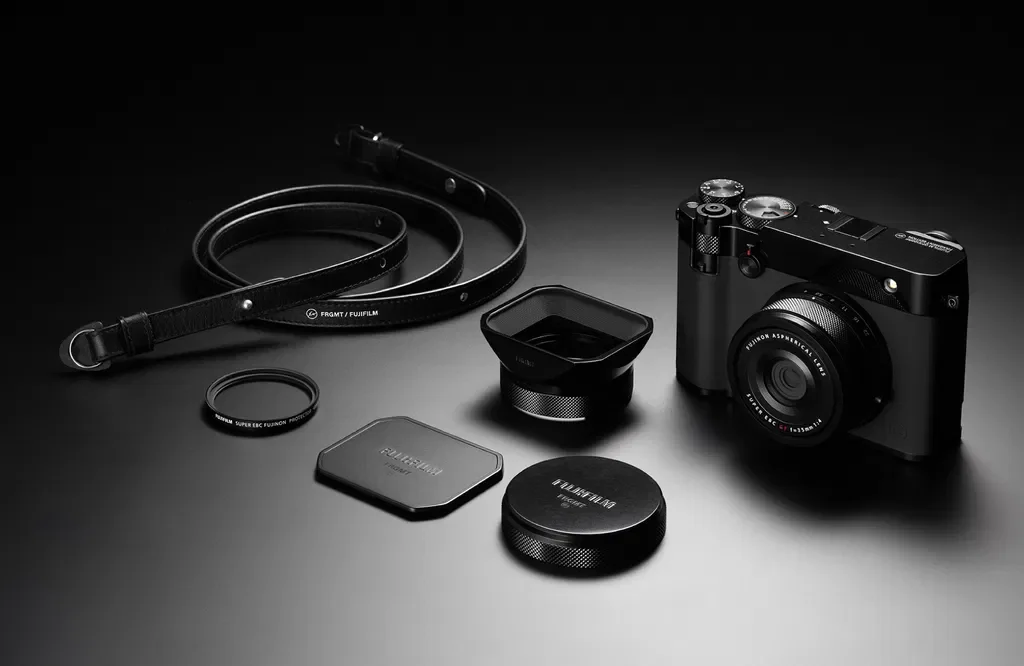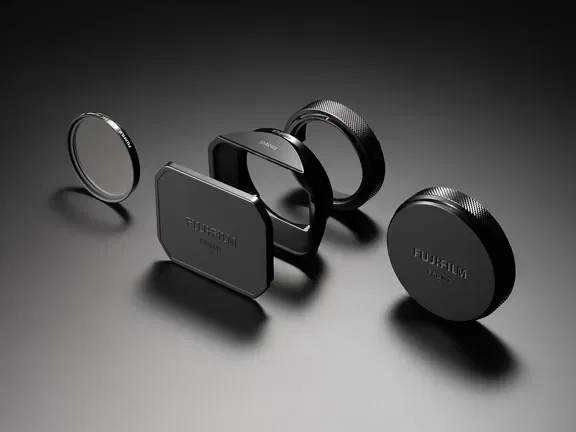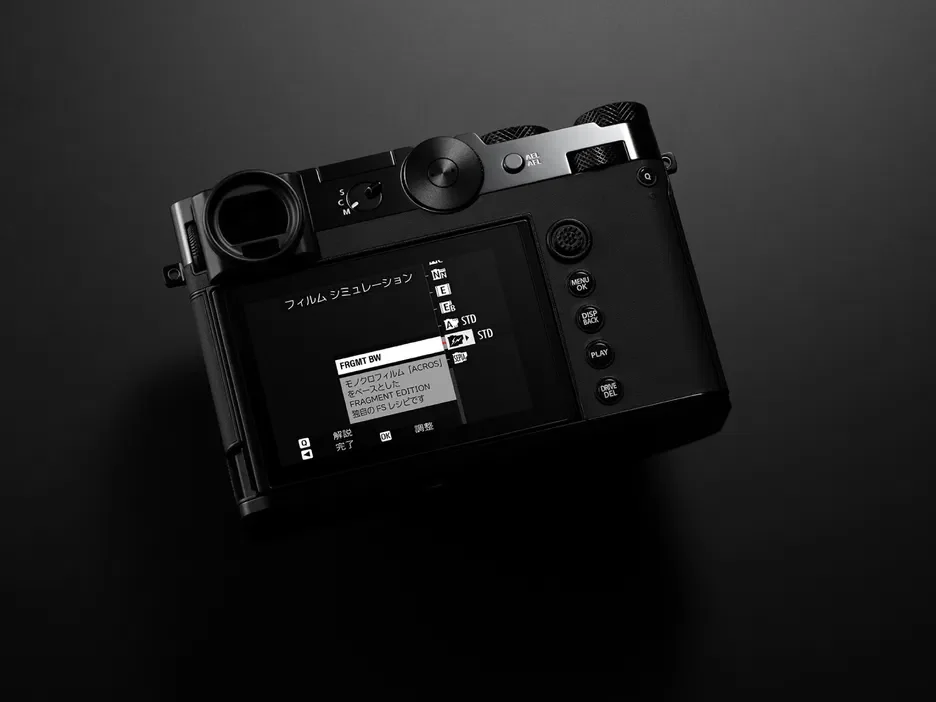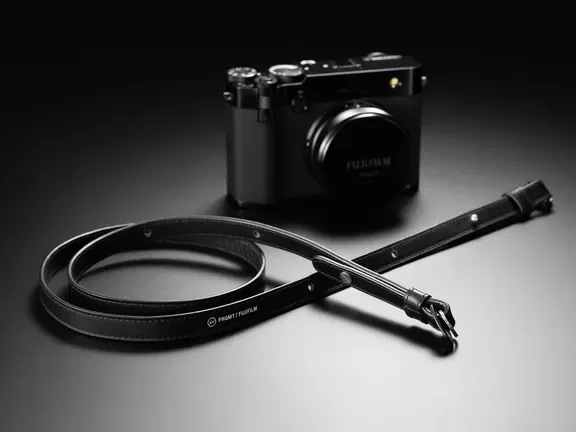Fujifilm GFX100RF Fragment Edition
GFX100RF FRAGMENT EDITION © Fujifilm
Every now and then, Fujifilm quietly drops something that makes you stop scrolling and just stare at the screen for a bit.
The FUJIFILM GFX100RF FRAGMENT EDITION is exactly that. A limited collaboration between Fujifilm and Hiroshi Fujiwara’s fragment design project, sold via Fujifilm Mall in Japan from 20 December 2025, and priced at 998,000 yen (£4,854, $6,348) for the full set.
On paper, it’s “just” a special edition of the GFX100RF. In reality, it feels like a love letter to black and white, street culture, and the idea that a camera can have a very specific, intentional look baked into it.
If I could actually get one, this might be my perfect GFX.
What Is The Fujifilm GFX100RF Fragment Edition?
At its core, the GFX100RF FRAGMENT EDITION is still the same camera I’ve already spent some time with: a fixed-lens GFX body with a 102MP large format sensor, X-Processor 5, and that lovely compact rangefinder-style form factor.
It keeps the things I already like:
102MP large-format sensor for ridiculous detail and cropping flexibility
Fixed 35mm f/4 lens (28mm full-frame equivalent) that suits street and documentary work
Aspect ratio dial on the back, which I already lean on for storytelling and layout in-camera.
The FRAGMENT EDITION then layers Fujiwara’s world on top of that base.
According to Fujifilm’s Japanese press release, it is:
A limited collaboration between Fujifilm and fragment design
Sold as a set via Fujifilm Mall in Japan only, from 20 December 2025
Priced at 998,000 yen including tax, which works out to roughly £4,800–£4,900 at current exchange rates.
There’s no mention at the time of writing of any official availability outside Japan. So if you’re in the UK like me, you’re in “import and hope” territory.
Design: Stealthy, Glossy And Very Fragment
The GFX100RF is already a nice-looking camera. The FRAGMENT EDITION takes that and pushes it firmly into the streetwear collab space.
From the press release:
The top plate (the “gunmetal” area) gets special anodising and repeated polishing to give it a highly reflective, mirror-like gloss with a deep, rich black tone.
The grip area uses a new material with tiny surface texture and a smooth, matte feel, so you get contrast between gloss and matte but still a unified all-black look.
The fragment design lightning logo appears subtly on the top plate, front of the camera and on the lens hood, plus a branded leather strap in the box.
The set includes a matching lens cap, hood, hood cap, strap, protector filter and adapter ring, all finished to match the body.
Visually, it is classic fragment: minimal, almost severe, but with a lot of attention to texture and finish. If you know Fujiwara’s work with Nike, Levi’s or Louis Vuitton, that quiet, logo-driven approach will feel very familiar.
From a documentary perspective, the all-black, low-key aesthetic is exactly what I want in a camera.
Nothing flashy, nothing to shout “expensive camera over here”. Just something that disappears into the background while you get on with the work.
FRGMT BW: A Built-In Monochrome Obsession
Here’s the bit that really got my attention.
The GFX100RF FRAGMENT EDITION includes a special film simulation recipe called FRGMT BW, based on ACROS but with fixed image settings tuned specifically for this camera.
Fujifilm actually lists the parameters in the press release. In plain language, FRGMT BW gives you:
ACROS as the base
Strong, large grain
A more aggressive tone curve (brighter highlights, deeper shadows)
Reduced sharpness and noise reduction
Increased clarity
A small positive exposure bias built into the look
In other words: punchy, grainy, high-contrast black and white that is not pretending to be clean digital. That might sound familiar if you’ve ever used my Kodak Double-X presets or any of the more “filmic” black and white looks I talk about.
There’s another interesting detail: Fujifilm notes that this model does not include the standard Monochrome and Monochrome+filter options. You still get all the usual colour simulations, but for pure mono you are essentially pointed towards ACROS and, if you are using the FRAGMENT EDITION, towards this FRGMT BW recipe.
I quite like that. It makes the camera feel a bit more like a signed print. You are buying into a particular interpretation of black and white, not just a body with all options turned on.
And of course, as someone who lives in black and white a lot of the time, I’m already thinking about how close I can get to FRGMT BW on my other Fujifilm bodies.
GFX100RF FRAGMENT EDITION © Fujifilm
Why This Might Be My Perfect Camera (If I Could Actually Get One)
If you’ve followed my work for any length of time, you’ll know a few things:
I love working in black and white, both for street and weddings.
I like cameras that are small, quiet and non-threatening.
I’ve spent the last decade leaning towards a documentary, story-driven way of seeing.
The GFX100RF in its standard form already ticks a lot of those boxes. It gives you medium-format tonality and detail in a body you can happily carry around all day, with a focal length that works beautifully for storytelling.
The FRAGMENT EDITION then adds three things that line up almost suspiciously well with how I like to shoot:
A monochrome-centric identity
It is very clearly leaning into a particular black and white character. That suits the way I tend to use cameras: I like to set up a camera with a look that feels “mine” and then just live in it. I don’t want to be constantly fiddling.A design that belongs on the street
Fujiwara has spent decades at the intersection of music, streetwear and everyday culture. He is called the “godfather of streetwear” for a reason.
A camera he has had a hand in is designed to feel comfortable in that environment. To me, that matters more than a spec sheet.A fixed lens that forces commitment
The 28mm equivalent focal length is fantastic for environmental portraits, street and documentary work. It nudges you to move, anticipate and commit, which is where all the interesting pictures tend to live.
Realistically, will I manage to get hold of one from a Japanese online store, navigate shipping, VAT and whatever else, all for a limited-edition version of a camera I already own and like? Probably not.
But as an object and as a concept, it is very close to how I think about cameras. A tool with a clear point of view, not a menu system full of maybes.
Who Is Hiroshi Fujiwara, And Why Does His Name Matter On A Camera?
If you are deep into streetwear or sneakers, you already know this. If you are mostly in the photography bubble, it is worth zooming out a bit.
Hiroshi Fujiwara:
Started out as a DJ in Tokyo, bringing early hip-hop records back from New York and helping popularise the music in Japan.
Was part of the original Harajuku scene, mixing punk, skate and hip-hop into what would become modern Japanese street fashion.
Founded brands like GOODENOUGH and later fragment design, which became less of a “normal” brand and more of a collaborative signature stamped across projects with Nike, Jordan Brand, Levi’s, Louis Vuitton, Moncler, Maserati and many more.
He often describes himself more as a collaborator or disruptor than a traditional designer. The fragment logo is almost like a seal of intent: this object belongs to a particular world of culture and taste.
Seeing that logo on a GFX body is interesting for a few reasons:
It connects large-format photography with the wider culture of streetwear and design.
It positions the GFX100RF FRAGMENT EDITION less as “a limited black camera” and more as part of a cross-disciplinary conversation.
It sends a small signal about where Fujifilm sees the GFX system living: not only in studios and landscape bags, but in the hands of people walking through cities, making pictures of real life.
As someone who has always been more drawn to the everyday, messy bits of life than to perfect, controlled scenes, that appeals to me more than any headline spec.
Availability Outside Japan: What We Know So Far
Right now, the official information is very simple:
Sales are via Fujifilm’s own Fujifilm Mall in Japan.
Orders open on 20 December 2025.
It is a limited edition; Fujifilm has not published a specific unit count in the press release.
The listed price is 998,000 yen including tax.
There is no mention of:
A UK or European allocation
Global dealers
Any separate “international version”
So if you are reading this in English and thinking “I want one”, the honest answer for now is that you would probably need to import it yourself or go through someone based in Japan.
Will that change? Possibly. Fujiwara’s collaborations often start in quite targeted ways and then ripple out in different forms.
But at the moment, it is safest to treat this as a Japan-only release.
Why A Camera Like This Matters (Even If You Never Buy One)
Most of us will never own a GFX100RF FRAGMENT EDITION. That is fine. For me, the interest is in what it says about where cameras might be heading.
A few quick thoughts:
Cameras as collaborations, not just products
Fujiwara has built an entire career out of carefully chosen collaborations that feel culturally specific and deliberate. Seeing that approach applied to cameras is exciting. It suggests more cross-overs between photographic tools and wider creative culture.A renewed focus on black and white
The fact that Fujifilm built a custom black and white recipe, published the settings, and removed some of the other mono options on this edition tells you something about intent. There is a quiet confidence in saying, “This is the look.”A nod to how people actually use high-res cameras
A compact, fixed-lens medium format camera with a deliberate, contrasty black and white look is not a lab instrument. It is a storytelling tool. And I think more of us are using high-resolution sensors in exactly that way: not to show off pixels, but to make pictures that feel like memories.
A Few Quick Questions You May Ask
-
It is a limited collaboration model of the GFX100RF, created with Hiroshi Fujiwara’s fragment design project. It keeps the 102MP large-format sensor and fixed 35mm f/4 lens, but adds a unique black finish, fragment branding and a dedicated FRGMT BW black and white film simulation recipe
-
Fujifilm’s Japanese press release lists the price as 998,000 yen including tax, sold via Fujifilm Mall. At current exchange rates that is roughly in the £4,800–£4,900 range, before any import costs.
-
At launch, Fujifilm only references sales through its own Japanese online store and does not mention any international distribution. So at the moment it appears to be a Japan-only release.
-
FRGMT BW is a custom black and white film simulation recipe exclusive to this camera. It is based on ACROS, with stronger grain, higher contrast, reduced sharpness and noise reduction, added clarity and a slight positive exposure bias, giving a punchy, film-like monochrome look.
-
I have already written a full article about using the regular GFX100RF in real-world shooting, with lots of sample images and notes on how I use the resolution and fixed lens in practice. You can find that here on my site.
All product images shown here are copyright © Fujifilm and are used for illustrative purposes only – you can see the originals on the official page at https://www.fujifilm-x.com/ja-jp/gfx100rf-fragment-edition.







